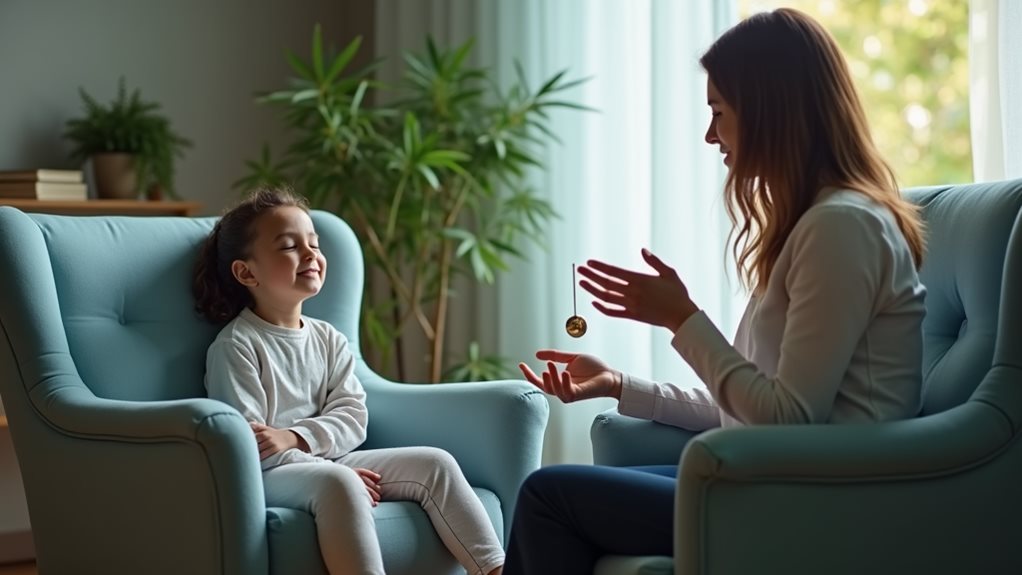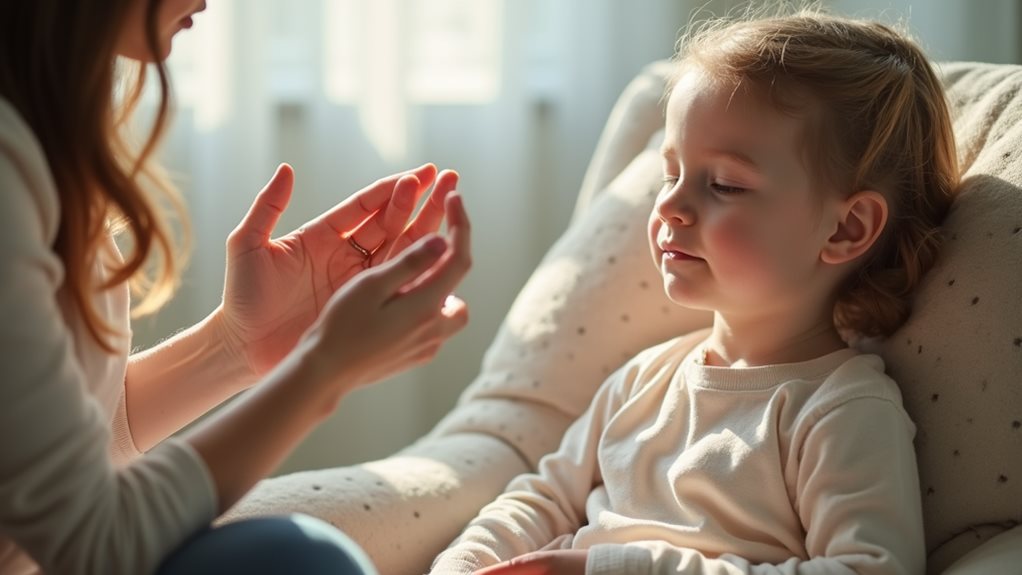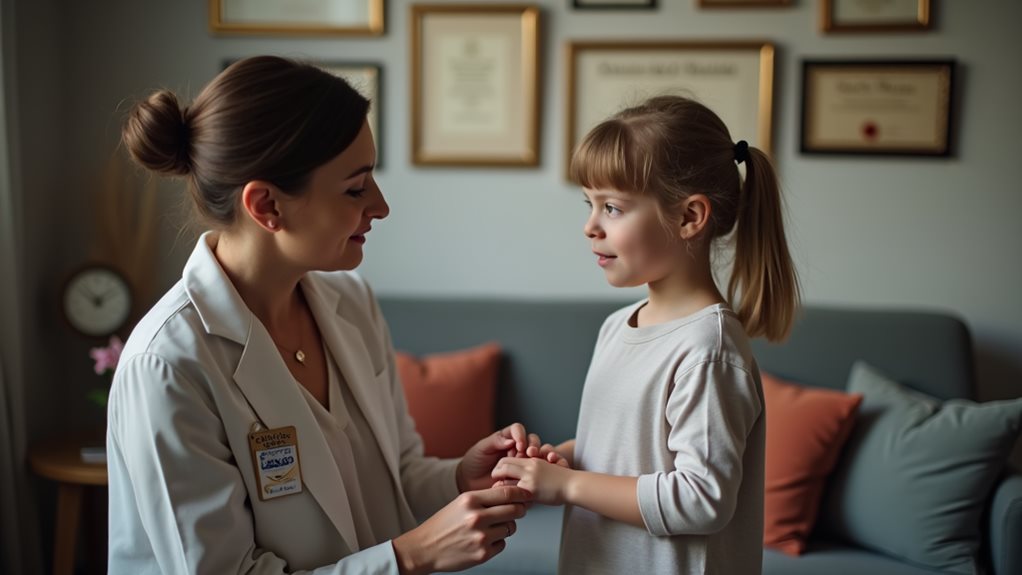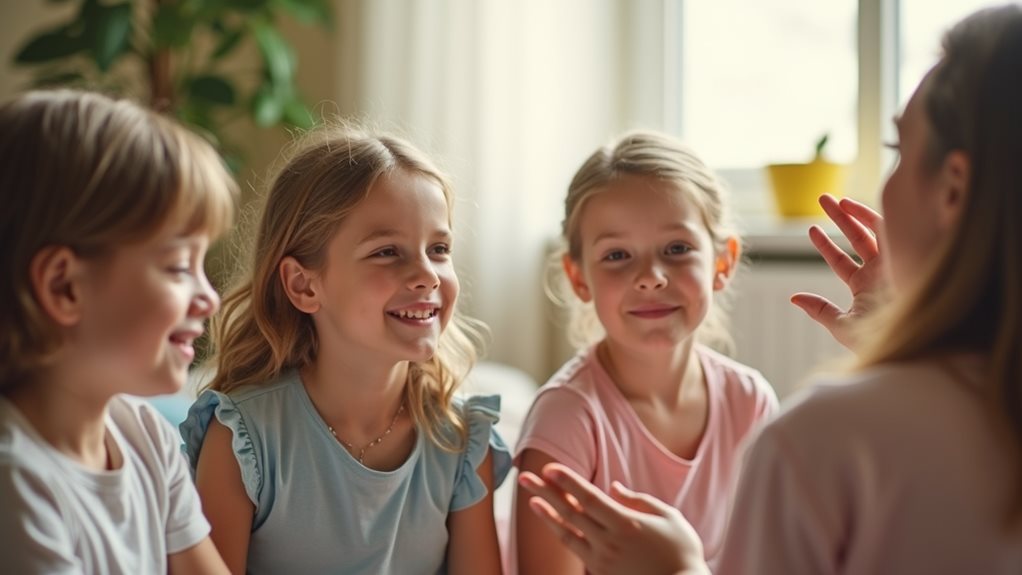
Hypnosis is a safe, effective tool designed to help children navigate various health and emotional issues by fostering deep relaxation and focused concentration. This therapeutic technique tailors its approaches—such as guided imagery and positive suggestions—to empower and teach kids essential coping skills for anxiety, pain management, and more. Engaging in hypnosis can promote significant improvements in a child's well-being and daily functioning. To uncover further insights into how hypnosis can benefit children, consider exploring more about its practices and outcomes.
Key Takeaways
- Hypnosis enhances relaxation, focus, and coping skills in children, addressing various emotional and physical issues.
- It teaches children effective stress and anxiety management techniques without medication.
- Safe and non-invasive, hypnosis empowers children to actively participate in their own healing process.
- Techniques like guided imagery, positive suggestions, and relaxation exercises are tailored to fit children's needs.
- Parental involvement is crucial, reinforcing techniques at home and monitoring progress for therapy success.
Understanding the Basics of Hypnosis for Children
Hypnosis for children serves as a gentle, yet powerful therapeutic tool designed to address a variety of emotional and physical issues.
Contrary to common hypnosis misconceptions, it is not about mind control but a guided process that enhances child relaxation and coping.
Through gentle suggestions and calming narratives, children are led into a state of focused awareness where they can access and influence their own subconscious thoughts.
This method helps in reducing anxiety, improving focus, and managing pain without the need for medication.
Exploring the Benefits of Hypnosis in Pediatric Health
As parents seek alternative and supportive treatments for their children's health issues, the role of hypnosis has become increasingly significant.
This non-invasive approach offers holistic benefits, focusing on child empowerment and emotional regulation. Through guided imagery and positive suggestions, hypnosis teaches children coping mechanisms to handle stress and anxiety effectively.
It fosters a sense of control and resilience, encouraging children to actively participate in their healing processes. Furthermore, hypnosis helps in the development of healthier habits and emotional responses, contributing to overall well-being.
This method is supported by research and is seen as a safe complement to traditional treatments.
Common Health Issues Alleviated by Hypnosis

Children grappling with a range of health issues find relief through the therapeutic application of hypnosis, which provides a gentle yet potent remedy for anxiety, insomnia, and various physical ailments.
Specifically, child anxiety, often manifesting as overwhelming worry or fear, can be greatly reduced. Hypnosis helps by instilling calmness and fostering a positive focus, enabling better behavior management.
This non-invasive approach also aids children in overcoming insomnia, ensuring a deeper, more restorative sleep.
Additionally, the techniques used in hypnosis teach children how to manage physical discomfort, from headaches to stomachaches, enhancing their overall well-being and resilience.
Preparing Your Child for Their First Hypnosis Session
Before starting their first hypnosis session, it is vital for parents to secure their child is adequately prepared and feels at ease with the process. Addressing hypnosis misconceptions is important; it is not mind control but a tool for self-improvement and relaxation. Preparing emotionally involves discussing the session positively and making certain the child understands they will be in control and safe throughout the experience.
| Aspect | Description |
|---|---|
| Understanding | Clarify what hypnosis is and isn't. |
| Emotional Prep | Discuss feelings and concerns openly. |
| Control | Make certain the child knows they can stop anytime. |
| Safety | Emphasize the session's safety and comfort. |
| Fun | Present hypnosis as a positive, fun experience. |
Techniques Employed in Pediatric Hypnosis

Pediatric hypnosis employs a variety of techniques tailored to meet the unique needs and developmental stages of children.
Utilizing age regression, practitioners help children revisit past experiences under safe conditions, fostering emotional regulation. Guided imagery and visualization skills are harnessed to create soothing mental landscapes, aiding in relaxation and achieving therapeutic goals.
Positive suggestions reinforce self-esteem and promote child empowerment, while tailored relaxation techniques teach effective coping mechanisms.
Session pacing is carefully managed to align with the child's attention span and responsiveness, ensuring each hypnosis experience supports their path towards healthier emotional and behavioral patterns.
Safety and Risks Associated With Hypnosis for Kids
While hypnosis is generally recognized as a safe and therapeutic practice for children, it is not without its potential risks and contraindications.
Hypnosis misconceptions may lead some to fear undue influence or control, which underscores the importance of maintaining clear therapeutic boundaries. It is vital for therapists to clarify that hypnosis is a guided process where the child's consent and comfort are paramount.
Rarely, some children may experience mild side effects like dizziness or confusion. Properly trained hypnotherapists can mitigate these risks, ensuring hypnosis serves as a secure tool for fostering resilience and healing in young individuals.
Identifying Qualified Hypnotherapists for Children

Choosing the right hypnotherapist for your child is an essential step in guaranteeing a positive and effective hypnotherapy experience.
When selecting a practitioner, contemplate their qualifications in hypnosis and child psychology to confirm they are well-equipped to handle the unique needs of children.
Here are key factors to ponder:
- Certification: Look for hypnotherapists with accredited hypnosis certifications that specialize in pediatric care.
- Experience: Prioritize professionals who have substantial experience in dealing with children's issues.
- Approach: Choose someone who uses a gentle, empathetic approach, suitable for the psychological and emotional development of children.
How Hypnosis Complements Traditional Treatments
Although hypnosis is often viewed as a standalone therapy, it can greatly enhance the effectiveness of traditional treatments for children. By fostering hypnosis integration, this complementary therapy synergizes with established medical protocols, potentially reducing the need for medication and accelerating recovery.
Hypnosis helps children cope with pain, anxiety, and stress, making them more receptive to treatments like psychotherapy. It equips them with relaxation and visualization skills that support their well-being.
Furthermore, these complementary therapies empower children, giving them active roles in managing their health. Consequently, hypnosis not only complements but enriches the therapeutic landscape for young patients.
The Ideal Age to Introduce Hypnosis to Children

Determining the most suitable age to introduce hypnosis to children requires careful consideration of their cognitive development and ability to follow instructions. Addressing child readiness and dispelling hypnosis misconceptions are essential.
Key Considerations:
- Cognitive Maturity: Typically, children around 7 or 8 have developed the necessary focus and comprehension.
- Emotional Stability: Ability to express emotions and handle mild stress is important.
- Misconceptions and Fears: Clear communication about what hypnosis involves can alleviate fears and correct any misconceptions.
Understanding these factors guarantees a more successful and positive hypnosis experience, tailored to the unique developmental stage of each child.
Setting Up an Appointment for Child Hypnosis Therapy
When considering hypnosis therapy for a child, setting up the initial appointment is an essential step. Understanding appointment logistics and session frequency is fundamental to align therapy with the child's needs. Parents should communicate openly with the therapist about the child's specific issues and what they hope to achieve.
| Aspect | Detail | Note |
|---|---|---|
| Scheduling | Flexible hours | Consider school schedule |
| Frequency | Weekly or bi-weekly | Adjust based on response |
| Duration | 1-2 hours per session | Tailored to child's focus |
| Preparation | Child-oriented | Engage with simple explanations |
Parents are encouraged to maintain a consistent schedule to maximize the therapeutic benefits for their child.
Frequently Asked Questions
How Often Should Children Undergo Hypnosis Sessions?
The frequency of hypnosis sessions for children varies based on age, specific issues, and individual responsiveness. Age considerations are essential; younger children may require shorter, more frequent sessions tailored to their developmental stage.
Can Hypnosis Help Improve Academic Performance in Children?
Hypnosis techniques may alleviate academic stress, potentially enhancing focus and memory retention in children. This scientifically informed approach could indirectly improve academic performance by creating a calm, conducive learning environment.
Are There Specific Times or Situations When Hypnosis Is Most Effective for Children?
Hypnosis is most effective for children during periods of heightened anxiety or when developing self-regulation techniques. These sessions can greatly aid in managing stress, enhancing focus, and improving overall emotional resilience in children.
What Should Children Wear During a Hypnosis Session?
Like a soft blanket on a chilly evening, children should wear comfortable clothing in calming colors during a hypnosis session to enhance relaxation and focus, fostering a secure, soothing environment conducive to therapeutic outcomes.
How Do Children Typically React After Their First Hypnosis Session?
Children's responses to their initial hypnosis session vary; some may feel relaxed and positive, while others could be skeptical or indifferent. First impressions often depend on the child's openness and the session's approach.
Conclusion
To sum up, hypnosis holds a harmonious horizon for healing in pediatric health care. Skillfully steering a child's subconscious towards serenity, this technique tenderly tackles trauma, tension, and turmoil without the taint of pharmaceuticals. Parents pondering this pathway must pursue proficient practitioners to protect and prioritize their progeny's well-being. With its proven potential, hypnosis harmonizes with traditional treatments, offering a holistic helper in the hearty health journey of our youngest.





